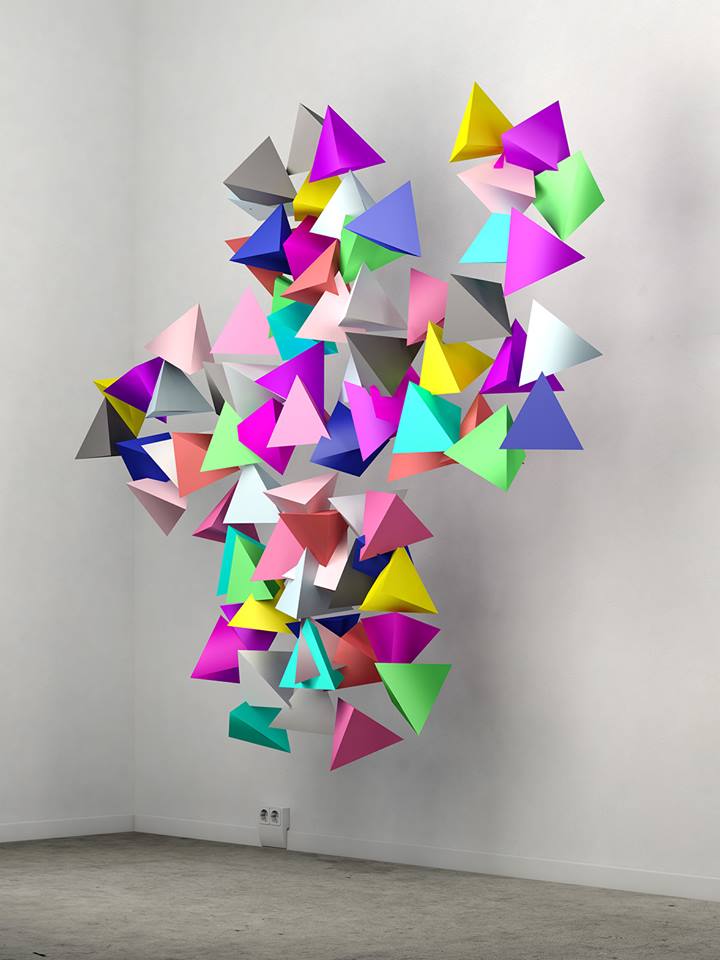
JEREMY BAILEY
ДЖЕРЕМИ БЭЙЛИ
제레미 베일리
ג’רמי ביילי
ジェレミー·ベイリー
colossus
Jeremy Bailey is a Toronto-based new media artist whose work explores custom software in a performative context.

ДЖЕРЕМИ БЭЙЛИ
제레미 베일리
ג’רמי ביילי
ジェレミー·ベイリー
colossus
Jeremy Bailey is a Toronto-based new media artist whose work explores custom software in a performative context.

Point Cloud
Point Cloud (ASU) is a newly commissioned artwork by Leo Villareal designed specifically for the ASU Art Museum in the Nelson Fine Arts Center. During his visit to the ASU Art Museum, Villareal was inspired by the museum’s architecture, designed by Antoine Predock in 1987. Villareal used mobile 3D scan technology to map both the inside and outside of the building, creating over 200,000,000 data points. The artist then manipulated the data points with his own custom software to create this public artwork. This is the first time Villareal has used actual data sampled from a location as part of an artwork.

After Party
(AI) infinite simulations
‘After Party’ is an animation about two young girls, Ada and Milica. They find themselves in a strange space where an adult party is happening. With every new simulation their personalities evolve in unpredictable ways: between Childhood and Adolescence, Refined and Savage. Our digital work consists of creating artificial environments in the form of real-time animation using our own custom software, where artificial intelligence characters interact with each other as well as with the virtual world that surrounds them. These pieces are usually inspired by stories or myths found in different cultures.

Эрнесто Клар
Convergenze parallele
Convergenze parallele is an audiovisual installation in which airborne dust particles passing through a beam of light are tracked, visualized, and sonified in realtime by a custom software system. The installation reacts to air movements in the exhibition space, allowing the viewer to see and hear the amplified movement of dust particles. “Convergenze parallele” explores the poetic potential of revealing and transforming the imperceptible. The custom software uses a video camera to capture the activity of dust articles passing through the beam of light. It then analyzes the video signal to track the location of individual dust particles, and reveals each particle’s trajectory in the image-processed projection. The physical particles draw traces of their otherwise invisible motion on the digital screen. At random intervals, the software artificially saturates the system by briefly activating the fan-a cloud of dust fills the beam of light and creates dense and stunning patterns of particle trajectories and sound.
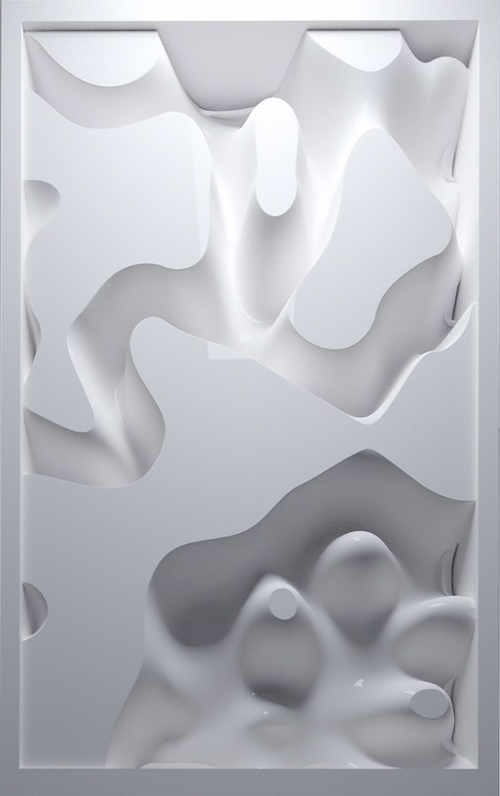
Wind of Boston: Data Paintings
Wind of Boston: Data Paintings is a site-specific work that turns the invisible patterns of wind in and around Boston into a series of poetic data paintings within a 6’ x 13’ digital canvas. By using a one-year data set collected from Boston Logan Airport, Refik Anadol Studios developed a series of custom software to read, analyze and visualize wind speed, direction, and gust patterns along with time and temperature at 20-second intervals throughout the year.
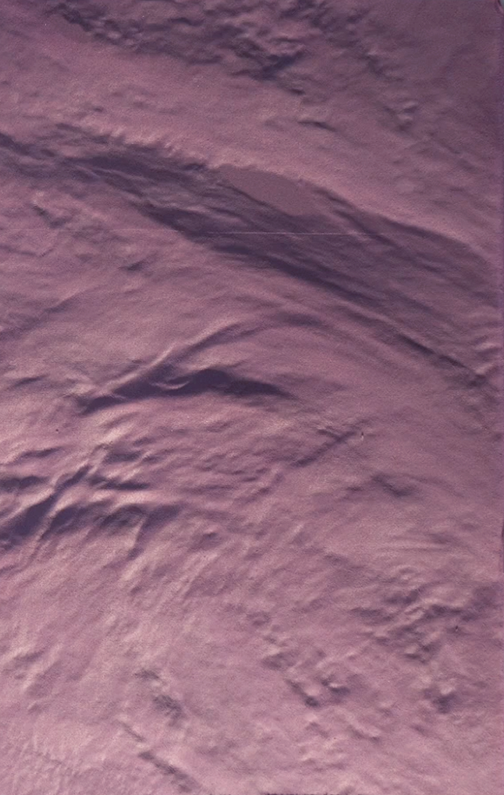
The other side
This installation automatically creates a three-dimensional relief carving of the current cloud formations and ocean surface conditions on the opposite side of the earth from the location of the gallery space. Using satellite data from the Nasa Earth Observing Information System and the GPS coordinates of the gallery, the installation obtains a current image of an approximately six hundred square mile area on the opposite side of the earth from its location. Using custom software, the system converts this image into a relief model that is sent to an onsite CNC machine hanging upside down in the gallery space. The CNC machine carves the relief in pink foam with its upside-down orientation directly echoing the cloud and ocean topography on the opposite side of earth.

Spacestream
The project uses generative computational strategies to generate series of special stream paths within 3D space frame, giving it structural stiffness and aesthetic values. The generative algorithm is based on use of multi-agent systems, shortest path calculation, lattice stigmergy and structural analysis. The goal is to create continuously thickened bundle paths within the fuzzy 3D space frame structure, where the bundles double as camouflage and reinforcement for the joints/seams between the welded components, allowing for fabrication of large scale structures, mediating between the discreet components and continuous system.Space Stream is a student project which aims to explore influence of rule-based design systems on low-tech fabrication technique of welding. The research concentrates on wireframe structures, which are strengthened through subdivision of basic geometrical units and bundling and reinforcing of the main structural strands. The custom software used for this project is centered on Dijkstra’s shortest path algorithm in combination with agent-based modeling techniques.

the Indistinct Notion of an Object Trajectory
Ryota Matsumoto’s drawings develop and demonstrate the hybrid/multi-layered process where varying scale, juxtaposition of different forms, intertwined textures/tones are applied to reinvent and question the spatial conditions of architectural drawings. His work explore a hybrid drawing technique combining both traditional media (ink, acrylic, and graphite) and digital media (algorithmic processing, scripting and image compositing with custom software ) .
FILE FESTIVAL
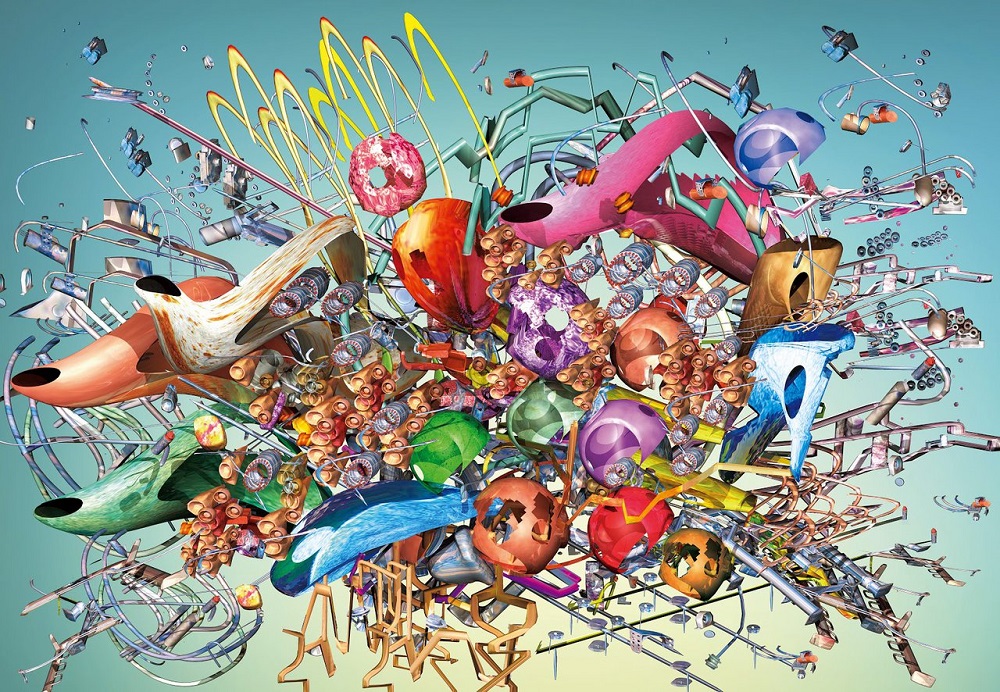
First Subtle Sign of Evolving Drones
Architecture, Art & Design – Ryota Matsumoto’s drawings develop and demonstrate the hybrid/multi-layered process where varying scale, juxtaposition of different forms, intertwined textures/tones are applied to reinvent and question the spatial conditions of architectural drawings. His work explore a hybrid drawing technique combining both traditional media (ink, acrylic, and graphite) and digital media (algorithmic processing, scripting and image compositing with custom software ) .
.

Simple Harmonic Motion study #5d
Behind the different incarnations, at the heart of the project lies the concept of creating complexity from simplicity. Through the use of custom software, a number of ‘agents’ are created and assigned a simple behavior. Each follow an extremely simple repetitive pattern of movement and sound. On their own, each agent is relatively monotonous, basic and mechanical. The repetition duration, motion and sound of each agent is precisely tuned such that the collection of all agents moving together, creates a unique, evolving and complex composition – both visually and sonically. The seed of inspiration comes from the motion of pendulums and other fundamental oscillatory phenomena which exhibit simple harmonic motion. The project extracts and amplifies these complex patterns, both through visual abstraction and emphasis; and also through sonifying the phenomena and creating musical patterns driven by the same equations that dictate the behaviour.

Scale
‘scale’ is an interspecies art project: an audience-interactive installation that involves nocturnal electric fish from the Amazon River Basin. Twelve different species of these fish comprise a choir whose sonified electrical fields provide the source tones for an immersive audiovisual environment. The fish are housed in individual tanks configured in a custom-built sculptural arc of aluminum frames placed around a central podium. The electrical field from each fish is translated into sound, and is thus heard — unprocessed or with digital effects added, with immediate control over volume via a touchscreen panel — through a 12-channel surround sound system, and with LED arrays under each tank for visual feedback. All software is custom-designed. Audience members interact as deejays with the system. Amongst the goals of the project is our desire to foster wider public awareness of these remarkable creatures, their importance to the field of neurological research, and the fragility of their native ecosystem.The project leaders comprise visual/conceptual artist Marlena Novak, composer/sound designer Jay Alan Yim, and neural engineer Malcolm MacIver. MacIver’s research focuses on sensory processing and locomotion in electric fish and translating this research into bio-inspired technologies for sensing and underwater propulsion through advanced fish robots. Novak and Yim, collaborating as ‘localStyle’, make intermedia works that explore perceptual themes, addressing both physical and psychological thresholds in the context of behavior, society/politics, and aesthetics.

New Humans
In New Humans, emergent gatherings of synthetic humans rise from the surface of a black ferrofluid pool. Appearing to morph like a supernatural life form, these dynamic clusters of magnetic liquid produced by machine learning processes are images of communities of synthetic people–hybrid profiles modeled from actual DNA, fitness, and dating profile data sets sourced from public and leaked caches. The work questions how we can radically conceptualize the “user profile” to embody a self whose bounds are indefinable and multiple. Generative algorithm using machine learning (GAN, T-SNE) and fluid simulation (Navier Stokes), countour generation (OpenCV), user profile data caches (DNA, fitness, and dating), software production (Processing), ferrofluid, custom electromagnet matrix, custom PCB control system, computer, steel, wood, aluminum.

SVNSCRNS
SVNSCRNS is a commissioning project that is initiated by Klankvorm after a concept by Joris Strijbos. The project consists of the realization of a kinetic audiovisual installation for which artists are invited to realize content. The installation can be used for live performances as well as for playing prearranged compositions. The installation consists of seven rotating projection screens and speakers that can be controlled from a central point. Custom build software and hardware are accessible for artists from different backgrounds to experiment with this new dynamic field for audiovisual composition. Light, sound and movement come together with different forms of digital media to create a multi sensorial experience for the audience. In this way the project functions as a platform in which makers and creators of all kinds can collaboratively explore this kinetic audiovisual medium. The result is a slow moving robotic structure which can display different sorts of media but in it’s presence will have a strong influence on the experience of the spectator.


Мути Рэндольф
මුටි රැන්ඩොල්ෆ්
মুটি র্যান্ডল্ফ
Generative Installation
Muti Randolph lives in Rio de Janeiro and studied Visual Communications and Industrial Design at the Pontificia Universidade Católica do Rio de Janeiro. One of the pioneers in computer art in Brazil, he has been shifting from virtual 3d to real 3d spaces creating sets, installations and interior architecture projects. In his work he explores the relation of time and space through music and interactive generative video using custom designed software and hardware. His projects are present in the most relevant art, design and architecture publications.
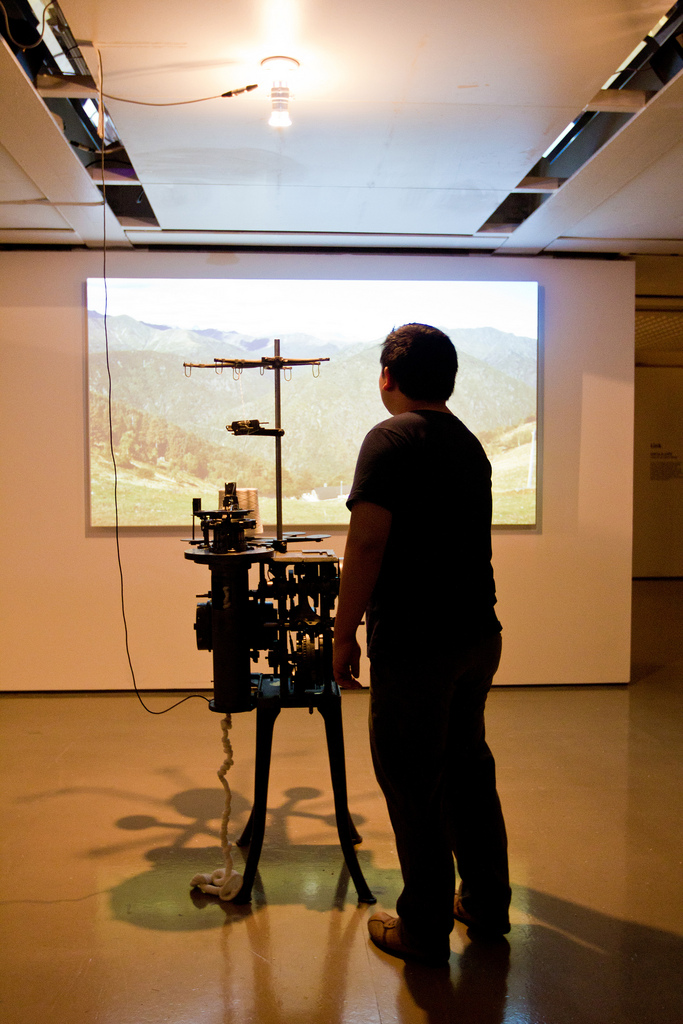
timeLandscape woolrhythms
“timeLandscape – wool rhythms” 2010. Part of timeLandscape series, 2009 – 2010. Video, audio, projector, speakers, custom patch (PD-Gem), sensor, wool engine. Variable dimensions and duration, loop. “timeLandscape – woolrhythms” is an interactive audiovisual installation in which a landscape is depicted from its multiple time possibilities and [re]composed through users’ real time interaction. The installation was developed in Biella, Italy, an area economically attached to textile industry, and deals with the cyclical perception of time and human, linear, interference on it. It gathers nature and artefact, by connecting a physical wool engine to digital imagery of daily cycles. By turning the wheel crank, users generate movement starting the engine. Through a sensor attached to the machine, software calculates the rotation speed, altering parameters for mixing audio and video fragments in real time. Every turn of the machine leads to different time thread combinations in response to the rhythm and speed of each interactor.
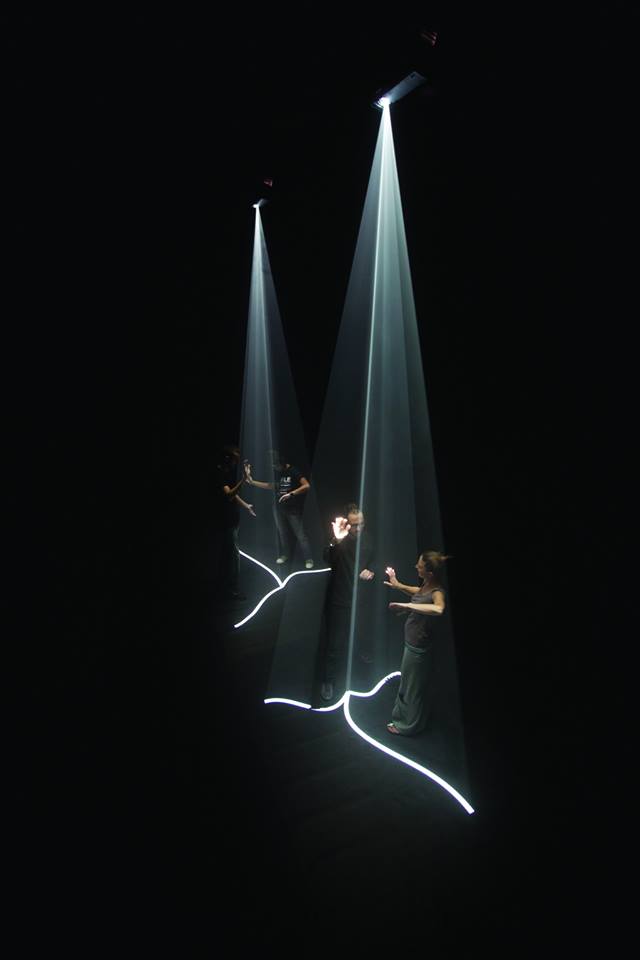
Эрнесто Клар
Luzes Relacionais
File Festival
“Luzes Relacionais” (Relational Lights) é uma instalação interativa audiovisual que explora a relação das pessoas com o caráter orgânico-expressivo do “espaço”. A instalação usa luz, som, neblina e um sistema de software customizado para criar um espaço-luz tridimensional de morphing (metamorfose), em que os espectadores participam ativamente, manipulando-o com sua presença e seus movimentos[…] A obra funciona como um organismo vivo, com ou sem a presença e a interação dos espectadores. Quando os espectadores saem da área de rastreamento ativo, o sistema começa seu próprio diálogo com o espaço através de extrusão e transformação de sequências de formas geométricas luminosas. Quando os espectadores penetram e interagem com o espaço-luz projetado, uma expressão coletiva e participativa do espaço se desdobra. “Luzes Relacionais” amplia o tecido tridimensional do espaço, tornando-o visível, audível e tangível aos participantes.

The Table
The Table is an autonomous robot with an automatic mechanized system able to react to unexpected movement or obstacles and to carry out one or more tasks by executing a program in a given environment. As is the case with most “prototypical” robotic works, or single editions, the basic physical components can be pre-manufactured then modified or custom built to meet specific needs. In the case of The Table, the control system and its algorithms were entirely conceived by Max Dean and Raffallo D’Andrea. All the components, including the wheels and motors, were also custom manufactured, giving the installation a unique character. The singular characteristic of this work lies in the robotic nature of the table and it’s capacity to operate in an environment specifically designed for it. For example, the shade of red painted on the floor is directly linked to the effective functioning of the camera and the control software. Also, the space lights used in the room produce a light that prevents the creation of shadows, which the software could mistakenly interpret as a physical presence.

MID AND PLAYMODES
radial and blaus
‘radial’ and ‘blaus’ are two interactive lighting installations, both a result of the collaboration between catalonia-based digital research collectives MID (media interactive design) and playmodes. ‘blaus’ introduces the abstract realm of three dimensional geometry through the mediums of audio and illumination – this could manifest as a cube or a blossoming flower, a grid or a jellyfish, a mutant framework of reflecting lights which submerge the audience into a multi-faceted universe, driven by hidden forces of the architecture. ‘blaus’ is an immersive space where audio-visual elements relate
intimately to impact on the visitor. the process led the designers to build most of the software and hardware elements themselves, by means of algorithm design, digital fabrication techniques and craft handwork. on the hardware side, the use of open source technologies, such as arduino, allowed us to create a flexible electronic system easily addressable by opensound – control data. ‘duration open source software by
james george was used in order to independently control, compose, and play a full score for the laser diodes, servomotors, lights and music.on the sound design side, all music and sound effects are made through the use of audio programming environments such as predate and reactor.
custom digital instruments are made in order to exactly match the resonant frequency of the space and its harmonics.
‘blaus’ is an immersive space where audio-visual elements relate intimately to impact on the visitor.